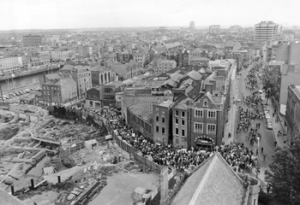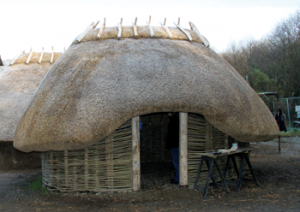A Viking house and garden at Glasnevin
Published in Editorial, Issue 2 (March/April 2014), Volume 22
Part of the 23 September 1978 ‘Save Wood Quay’ demonstration on Fishamble Street. The plan is to recreate a typical Fishamble Street house with its attendant garden, as evidenced by the excavations undertaken there between 1974 and 1981. (Thaddeus C. Breen)
Those who have experienced the beautiful buildings and smell of wood smoke at Ferrycarrig Heritage Park in Wexford will know the sense of immediacy and delight a well-crafted replica building can bring to the past. Having an outdoor building of this quality close to the medieval excavations of the centre of Dublin was one of the major inspirations for the project at the National Botanic Gardens. The plan is to recreate a typical Fishamble Street house with its attendant garden, as evidenced by the excavations undertaken at Wood Quay and Fishamble Street between 1974 and 1981. Another reason for building the house is to mark this year’s millennium of the Battle of Clontarf. The site of the gardens on the banks of the Tolka River was no doubt witness to some part of the fighting. The house and its attendant garden will form a graceful addition to the gardens for many years to come.
There are several reasons why building such a replica fits well with our mission. The Botanic Gardens run an extensive education programme and cater for many thousands of visiting schoolchildren. The aim will be to take groups of up to 30 children at a time into the house and talk about life in Hiberno-Norse Dublin 1,000 years ago.
One of the most striking feat-ures of these buildings is that they are entirely organic and constructed exclusively from plant resources. The amount of raw material needed for such a building, the land area required to supply these materials and the years it took for that to be replenished feature in many of our sustainability-focused garden tours and workshops. A large proportion of the world’s population still live in such buildings, and the house will provide an excellent focus on sustainability and the importance of plants then and now.
Visitors will be able to understand the construction of houses of the time, as well as how evidence gathered from fireplaces, floors and bedding areas can reveal how people lived and the foods they ate. This will have a direct bearing on both the junior and senior cycle curricula. We hope that it will also open young minds to the role of archaeology in teaching us about the past and the possibilities of a career in this area.

A Hiberno-Norse house reconstruction at the Irish National Heritage Park, Ferrycarrig, Co. Wexford, by Eoin Donnelly, who will oversee the construction of the Glasnevin building.
The National Botanic Gardens is a scientific institution and one of its many research interests is the origins of the Irish flora. Many species of flowering plants—our native flora—reached Ireland by entirely natural means over 9,000 years ago. It is likely, however, that people introduced a further 100 or so plant species—so-called archaeophytes—between the Neolithic and medieval eras. The surrounding garden will therefore exhibit not only the crops and utility plants of the time but also, importantly, the weeds of cultivation that we know were abundant at the time. Examples of ash, hazel and oak trees will demonstrate the source materials of the building, while plants used for thatching and for bedding material and wild-sourced plant foods will make the garden a fascinating piece of living archaeology.
Eoin Donnelly of Enniscorthy will oversee construction of the building, with assistance from Botanic Gardens staff. The building phase during March and April will be a major attraction and we plan to maintain a running commentary on progress on our website and Facebook pages (www.botanicgardens.ie). Depending on the weather, the house should be ready by Easter Week, and the garden will develop over the next year or so.
The house has come about through the enthusiastic support of many partners, especially Dublin City Council, the National Museum of Ireland and the School of Archaeology, University College Dublin. We have received generous financial assistance from the Irish Museums Trust and Dublin City Council.
Matthew Jebb is Director of the National Botanic Gardens.
















